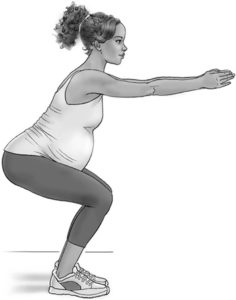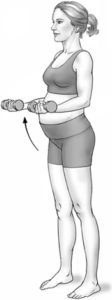 You’re aching and you can’t sleep and your back is killing you and your ankles are swelling and you’re constipated and bloated and you’re passing more gas than a busload of high school football players who just stopped for fast food. In other words, you’re pregnant. Now, if only there were something you could do that might minimize the aches and pains and unpleasant side effects of pregnancy.
You’re aching and you can’t sleep and your back is killing you and your ankles are swelling and you’re constipated and bloated and you’re passing more gas than a busload of high school football players who just stopped for fast food. In other words, you’re pregnant. Now, if only there were something you could do that might minimize the aches and pains and unpleasant side effects of pregnancy.
Actually, there is, and it’ll take just minutes (make that 30 minutes) a day: exercise. Thought pregnancy was a time to take it easy? Not anymore. Lucky for you (or unlucky, if you’re a member of the couch potato club), the official advice of ACOG reads like a personal trainer’s pep talk: Women with normal pregnancies should get 30 minutes or more a day of moderate exercise on most (if not all) days.
And barring any activity restrictions from your practitioner, you can, too. It doesn’t matter whether you started out as an iron woman in peak physical condition or a sofa slacker who hasn’t laced up sneakers since your last gym class (except as a fashion statement). There are plenty of perks to exercising for two.
Exercise Smarts
Exercising with a baby on board? Remember to use your exercise smarts:
■ Replenish fluids. For every half hour of moderate activity, you will need at least a full glass of extra liquid to compensate for fluids lost through perspiration. You will need more in warm weather or whenever you’re sweating a lot. Drink before, during, and after exercising—but no more than 16 ounces at a time. It’s a good idea to start your fluid intake 30 to 45 minutes before your planned workout.
■ Bring on the snacks. A light but sustaining before-workout snack will help keep your energy up. Follow up with a light snack, too, especially if you’ve burned a lot of calories. You’ll have to consume about 150 to 200 additional calories for every half hour of moderate exercising.
■ Stay cool. Any exercise or environment that raises a pregnant woman’s temperature more than 1.5 degrees should be avoided (it causes blood to be shunted to the skin and away from the uterus as the body attempts to cool off). So stay out of saunas, steam rooms, or hot tubs, and don’t exercise outdoors in very hot or humid weather or indoors in a stuffy, overheated room (no Bikram or hot yoga). If you generally walk outdoors, try an air-conditioned mall instead when the temperature soars.
■ Dress for exercise success. Play it cool by wearing loose, breathable, stretchable clothes. Choose a sports bra that provides plenty of support for your probably bigger breasts but doesn’t pinch once you get moving.
■ Put your feet first. If your sneakers are showing their age, replace them now to minimize your chances of injury or falls. And make sure you choose workout shoes that are designed for the sport you’re pursuing.
■ Select the right surface. Indoors, a wood floor or a tightly carpeted surface is better than tile or concrete for your workouts. (If the surface is slippery, don’t exercise in socks or footed tights.) Better yet, invest in a yoga mat that can do double duty as a surface for your cardio workout as well. Outdoors, soft running tracks and grassy or dirt trails are better than hard-surfaced roads or sidewalk, and level surfaces are better than uneven ones.
■ Stay off the slopes. Because your growing bump will affect your sense of balance, ACOG suggests women in the latter part of pregnancy avoid sports that come with a higher risk of falling or abdominal injury. These include gymnastics, downhill skiing or snowboarding, ice skating, vigorous racquet sports (play doubles instead of singles), and horseback riding, as well as cycling and contact sports such as ice hockey, soccer, and basketball.
■ Stay on the level. Unless you’re living at high altitudes, avoid any activity that takes you up more than 6,000 feet. On the flip side, scuba diving, which poses a risk of decompression sickness for your baby, is also off-limits, so you’ll have to wait until you’re no longer carrying a passenger to take your next dive.
■ Stay off your back. After the 4th month, don’t exercise flat on your back. The weight of your enlarging uterus could compress major blood vessels, restricting circulation.
■ Avoid certain moves. Some moms-to-be find that pointing (or extending) their toes can lead to cramps in their calves. If that’s the case with you (and it probably won’t be if you’re a regular at the barre), flex your feet instead, turning your toes up toward your face. Full sit-ups or double leg lifts pull on the abdomen, so they’re probably not a good idea when you’ve got a baby on board. Also avoid any activity that requires “bridging” (bending over backward) or other contortions, or that involves deep flexion or extension of joints (such as deep knee bends), jumping, bouncing, sudden changes in direction, or jerky motions.
 Choosing the Right Pregnancy Workouts
Choosing the Right Pregnancy Workouts
While it’s true that pregnancy isn’t the time to learn to water ski, snowboard, or enter a horse-jumping competition, you’ll still be able to enjoy most fitness activities—and use many of the machines at the gym (with a few caveats). You can select, too, from the growing number of exercise programs specifically designed for expecting moms (pregnancy water aerobics, pregnancy Pilates, and prenatal yoga classes, for example). But be sure to ask your practitioner about what’s okay and what’s not when it comes to choosing an exercise program or sport. You’ll probably find that most of the activities that are off-limits when you’re expecting are ones you’d probably have a hard time doing well anyway once you have a basketball-size belly (like competitive basketball . . . or football or scuba diving or downhill racing or mountain biking). Here are some of the do’s and don’ts of pregnancy workouts:
Walking. Just about anyone can do it—and do it just about anywhere, anytime. There’s no easier exercise to fit into your busy schedule than walking (don’t forget, all the walking you do counts, even if it’s walking 2 blocks to the market or 10 minutes while the dog does her business). And you can continue to fit it in right up until delivery day (and even on delivery day if you’re eager to get those contractions moving along). Best of all, there’s no equipment necessary—and no gym membership or classes to pay for, either. All you need is a supportive pair of sneakers and comfortable, breathable clothes. If you’re just beginning a walking routine, go slowly at first (start out at a stroll before you move on to a brisk pace). Weather’s not cooperative? Do a power mall walk.
Jogging. Experienced runners can stay on track during pregnancy—but you may want to limit your distances and stick to level terrain or use a treadmill (if you weren’t a runner prepregnancy, stick to brisk walking for now). Keep in mind that loosening ligaments and joints during pregnancy can literally be a pain, make running harder on your knees, and also make you more prone to injury—all good reasons to listen to your pregnant body and adjust your runs accordingly
 Exercise machines. Treadmills, ellipticals, and stair-climbers are all good bets during pregnancy. Adjust speed, incline, and tension to a level that’s comfortable for you (starting out slowly if you’re a rookie). Toward the end of your pregnancy, though, you may find a machine workout too strenuous (or maybe not—as always, take your cues from your body). You may also have to be more conscious of avoiding stumbles on the machine when you’re no longer able to see your feet.
Exercise machines. Treadmills, ellipticals, and stair-climbers are all good bets during pregnancy. Adjust speed, incline, and tension to a level that’s comfortable for you (starting out slowly if you’re a rookie). Toward the end of your pregnancy, though, you may find a machine workout too strenuous (or maybe not—as always, take your cues from your body). You may also have to be more conscious of avoiding stumbles on the machine when you’re no longer able to see your feet.
Swimming and water workouts. Consider this: In the water, you weigh just a tenth of what you do on land (how often do you have the chance to be close to weightless these days?), making water workouts the perfect choice for a pregnant woman. Working out in the water boosts your strength and flexibility but is gentle on your joints—plus there’s much less risk of overheating (unless the pool is overheated). What’s more, many pregnant women report that water workouts help ease swelling in their legs and feet and relieve sciatic pain. Most gyms with a pool offer water aerobics, and many have classes specifically designed for expectant moms. Just be careful when walking on slippery pool sides, and don’t dive in.
Yoga. Yoga encourages relaxation, focus, and paying attention to your breathing—so it’s just about perfect for pregnancy (and great preparation for childbirth, as well as for parenting). It also increases oxygenation (bringing more oxygen to the baby) and increases flexibility, possibly making pregnancy—and delivery—easier. Select a class that’s specifically tailored to expectant women or ask your instructor how to modify poses so that they’re safe for you. For instance, you probably shouldn’t exercise on your back after the 4th month, and as pregnancy progresses your center of gravity changes, so you’ll have to adjust your favorite poses accordingly. And unless you’re an experienced yoga inversion practitioner, you should probably avoid full inversions (handstand, supported shoulder stand, and supported headstand) after the 3rd month—not only because your balance will be off, but also because of potential blood pressure issues. Some doctors and midwives say half inversions—like downward facing dog—are okay during pregnancy.
Another important caveat: Avoid Bikram or hot yoga. It’s done in a very warm room (one that’s generally 90°F to 100°F), and you’ll need to take a pass during pregnancy on any workouts that heat you up too much.
Pilates. Pilates is similar to yoga in that it’s a discipline that improves your flexibility, strength, and muscle tone with no- to low-impact. The focus is on strengthening your core, which will ease backaches and improve your posture (important for preventing aches and pains when you’re toting a baby in your belly, but also when you’re toting one in your arms). Look for a class specifically tailored to pregnant women, or let your instructor know that you’re expecting so you can avoid pregnancy-inappropriate moves (including those that overstretch) or equipment that isn’t compatible with pregnancy.
Barre classes. These ballet-inspired workouts are great when you’re expecting because they include lots of legwork with minimal jumping. The balance exercises and core strengthening are pregnancy perfect, too, especially when your swelling belly slackens the core and throws you off balance. So belly up to the barre, but with a little mom-to-be modification: Since some of the lower-body movements may put strain on your back, especially as your belly gets bigger, adapt movements (such as by getting to your hands and knees for certain positions) as needed.
 Spinning. Is spinning in when you’re expecting? If you’ve been spinning for at least 6 months before pregnancy, you should be able to continue, but tone down the workout (and let the instructor know you’re expecting so you’re not pushed too hard). Remember to take it down a notch if you’re panting or gasping for breath. And for maximum comfort, adjust the handlebars so they’re closer to you, allowing you to sit back instead of leaning forward, which could make your lower back ache more than it likely already does. Stay seated, since standing while spinning is too intense for a mama-to-be. If spinning suddenly seems exhausting, take a bike break until after the baby’s born (and after you’ve recovered from childbirth).
Spinning. Is spinning in when you’re expecting? If you’ve been spinning for at least 6 months before pregnancy, you should be able to continue, but tone down the workout (and let the instructor know you’re expecting so you’re not pushed too hard). Remember to take it down a notch if you’re panting or gasping for breath. And for maximum comfort, adjust the handlebars so they’re closer to you, allowing you to sit back instead of leaning forward, which could make your lower back ache more than it likely already does. Stay seated, since standing while spinning is too intense for a mama-to-be. If spinning suddenly seems exhausting, take a bike break until after the baby’s born (and after you’ve recovered from childbirth).
Weight training. Using weights can increase your muscle tone (and get your biceps ready for lifing baby), but it’s important to avoid heavy weights or those that require grunting or breath holding, which may compromise blood flow to the uterus. Use light weights with multiple repetitions instead. Ask your practitioner about what modifications you’ll need to make to your TRX routine (or whether you should retire the equipment for the duration) and skip those CrossFit routines for now (unless you’ve been at it for years and your practitioner gives you the thumbs-up).
Excerpted from the newly published 5th edition of What to Expect When You’re Expecting.





No Comments